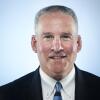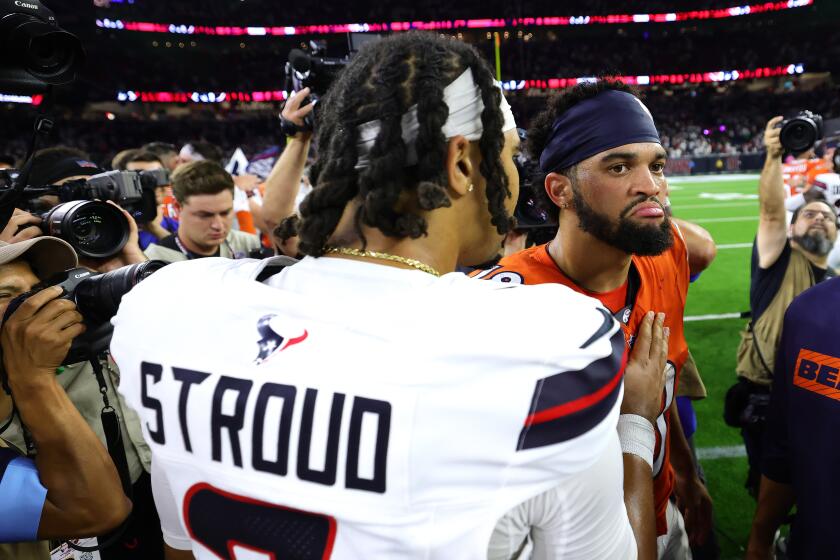USC’s Matt Barkley says his play’s the thing in Heisman campaign
Matt Barkley envisions his main role in any Heisman Trophy campaign to be devoid of endless interviews, slickly produced highlight reels, social media posts, high-tech phone applications and promotional gimmicks.
“My campaign,” the USC quarterback says, “is on the field.”
Barkley, though, easily handled a bull-rush of attention at Pac-12 Conference media day earlier this week. He saw the demands coming the second he passed on the opportunity to turn pro and announced he would return to USC for his senior season.
And the self-described “tech nerd” even had a hand in developing what USC hopes will be a fan-friendly mobile app to promote Barkley and deliver information about the Trojans.
The school billed the app “PROJECT TRO7AN,” a play on Barkley’s jersey number.
But USC also is attempting to avoid oversaturation.
Barkley shares the front of the school’s schedule poster with seven other players. He also is part of a group shot on the cover of the football media guide. And USC’s new app will include information about all players, not just the one regarded by many as the front-runner for college football’s most coveted honor.
“He goes in as ‘the guy,’” USC sports information director Tim Tessalone says, “so you don’t have to do a lot of setting the table.”
Barkley can do much of that on his own. He is an active social media user with more than 58,000 followers on Twitter. On Wednesday, an “Ask Me Anything” Reddit.com interview generated nearly 1,500 comments. (The only class Barkley will take this fall is the tech-based “Macintosh, OSX, and iOS Forensics.”)
For all his willingness to engage fans and reporters, Barkley said his approach this season would be simple: “Just shut up and do work.”
Coach Lane Kiffin is a likely advocate. Kiffin, who was a USC assistant when quarterbacks Carson Palmer and Matt Leinart and tailback Reggie Bush won the Heisman, is expected to do everything possible as a play-caller to ensure that Barkley remains at the forefront of the Heisman discussion.
“We do have a tradition of throwing a lot of touchdown passes,” Kiffin says, laughing, “but it won’t be based on the Heisman.”
Barkley, who passed for 39 touchdowns last season, is aware of Kiffin’s standing as one of the most statistics-conscious coaches in college football.
“Yes,” he says, grinning broadly. “And I love it.”
Seven USC players have won the Heisman, tying Notre Dame and Ohio State for the all-time lead, even though the Trojans typically refrain from over-the-top campaigns.
“I don’t think they overdo it,” says broadcaster Keith Jackson, a Heisman voter who called college football games for more than 50 years. “They’re just damn good at it.”
Tessalone, USC’s sports information director since 1984, says the philosophy is simple: “A steady disbursement of information during the season, and ramp it up when appropriate.”
USC’s approach to promoting Heisman candidates has evolved through the years.
In 1965, the cover of USC’s football media guide featured the school seal but no photographs. Spreading the word about Mike Garrett, the first Trojan to win the Heisman, was left to Coach John McKay, who stumped for the tailback before and during the season.
Tailback O.J. Simpsonwas the first player to be featured on the cover of USC’s media guide, though he was not identified by name. On the back cover, there was a photo of Simpson with the phrase, “All the way with O.J,” the headline on Sports Illustrated’s account of USC’s 1967 victory over UCLA and Heisman winner Gary Beban, which featured a legendary 64-yard touchdown run by Simpson.
In 1974, per McKay’s instruction, Heisman hopeful Anthony Davis shared the media guide cover with five teammates. A voting deadline that passed before Davis’ performance in the Trojans’ historic 55-24 comeback victory against Notre Dame short-circuited the tailback’s Heisman hopes. He finished second behind Ohio State’s Archie Griffin.
Two years later, after tailback Ricky Bell finished third in the 1975 Heisman voting, new coach John Robinson and USC took a small step into the hype game. An action photo of Bell appeared on the cover of the 1976 media guide with type that identified him as a “Heisman Trophy Candidate.”
Back then, schools appeared on national television only a few times each season. Contact with media largely was done through mail and early-in-the-week “advance” trips by sports information officials to cities where the Trojans would play next.
The Trojans lost their opener against Missouri but Bell scored four touchdowns in a 53-0 victory at Oregon the following Saturday. With a game at Purdue next, Jim Perry, USC’s sports information director at the time, traveled to Chicago for a Big Ten Conference media luncheon on the Tuesday after the Oregon game. As he handed out photos and copies of news stories, several media members asked him the same question:
“How did Bell do in his last game?”
Perry laughs when recalling the information lag.
“That game was on the West Coast, at night, and there were no TV highlights or Internet,” he says, “Nothing tells you more about how times have changed.”
In 1979 and 1981, USC tailbacks Charles White and Marcus Allen got media-guide cover treatment similar to Bell’s and won the Heisman without high-powered campaigns. Quarterback Rodney Peete appeared in a posed shot on the media guide cover in 1988, the year he finished second to Barry Sanders in Heisman voting.
Fourteen years later, with every game on television and highlights looping throughout the day and night, USC subtly ventured deeper into the promotion game.
In 2002, Palmer was not regarded as a preseason Heisman favorite. A fifth-year senior, he was relegated to the back of the media guide while a photo of safety Troy Polamalu appeared on the front. But after Palmer passed for five touchdowns in a late-October victory at Oregon, USC began courting Heisman voters.
It mailed to media members an envelope-sized card that served as a ticket to “The Carson Show,” a play on “The Tonight Show Starring Johnny Carson.” An action photo of Palmer and his statistical highlights were emblazoned on the card.
The campaign raised awareness, stirring national debate about Palmer’s chances as a West Coast candidate. By the time USC played Notre Dame in late November, Palmer was at the forefront of Heisman discussion. His four-touchdown performance against the Fighting Irish clinched the Heisman victory.
Two years later, USC featured quarterback Matt Leinart on the cover of the media guide. It also started a blog for Leinart that was ghostwritten by a sports information office staffer. As the Trojans moved through an unbeaten season, USC disseminated highlight videos of Leinart and Bush online. Both players became Heisman finalists, Leinart taking home the trophy.
In 2005, Leinart and Bush appeared on the cover of a collectible hardcover media guide that was shipped in shrink wrap. The school also produced print information and highlight videos during the season. Bush beat out Leinart and Texas quarterback Vince Young for the Heisman, but five years later had to return the trophy after being declared ineligible for the ’05 season.
Last season, Barkley made a run for consideration as a Heisman finalist, setting records and leading the Trojans to a victory at Oregon and a season-ending rout of UCLA. Unlike Davis, whose chances suffered because voting ended too early in 1974, Barkley experienced a Heisman setback of sorts because voting ended after conference championship games, which USC could not participate in because of NCAA sanctions primarily stemming from the Bush case.
As Barkley sat idle, Louisiana State cornerback Tyrann Mathieu starred in the Southeastern Conference title game, earning a trip to New York as a Heisman finalist.
USC’s two-year postseason ban is over, so Barkley could play in the Pac-12 title game before the Heisman voting deadline.
He is prepared for “Heisman front-runner” to precede his name throughout the season if he performs well. But he’s not especially fond of the phrase.
“I kind of just blank it out,” he says. “That name isn’t going to make me play any better.”
twitter.com/latimesklein
More to Read
Go beyond the scoreboard
Get the latest on L.A.'s teams in the daily Sports Report newsletter.
You may occasionally receive promotional content from the Los Angeles Times.







